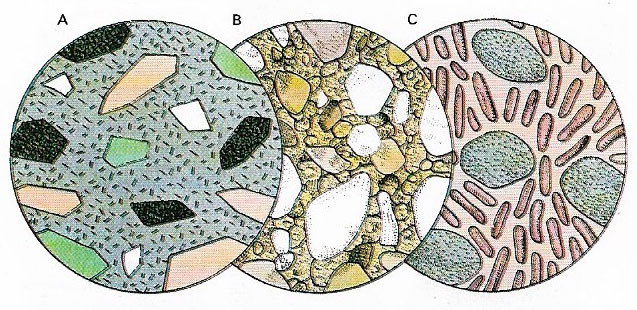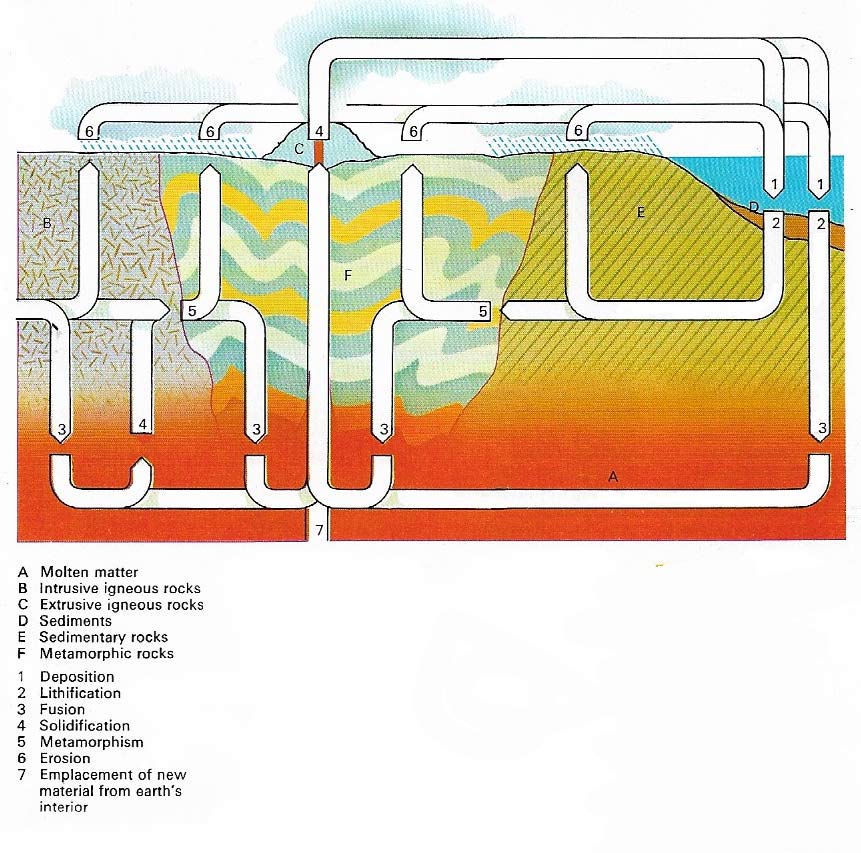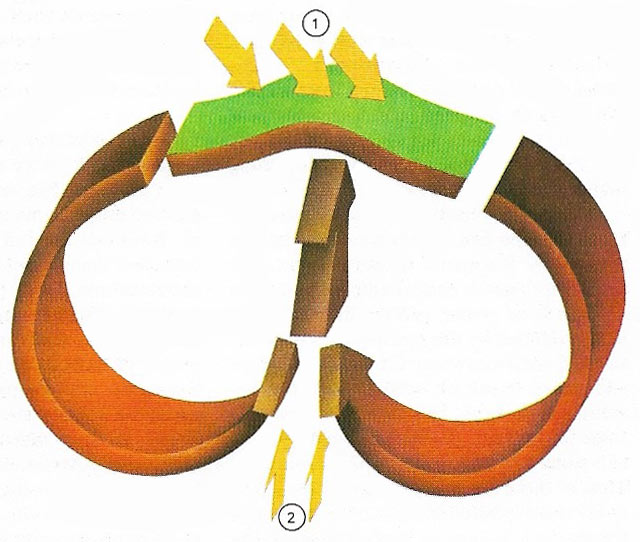rock cycle

Figure 1. Textures can be used to identify rock types. Igneous rocks (A) show well-developed crystals , sedimentary (B) contain older pieces, and metamorphic (C) show the stresses under which they formed.

Figure 2. The rock cycle is the slow change from one rock type to another. Erosion produced sediments which harden to form sedimentary rocks. If these are deeply buried the temperature and pressure turn them into metamorphic rocks. Intense heat at great depths melts metamorphic rocks. This rock may be pushed up to the surface where it cools to form igneous rocks. There erosion begins the cycle again.

Figure 3. The energy to power the rock cycle is derived from the heat of the Sun (1), which indirectly breaks down existing sediments, and the heat from the Earth's interior (2), due to radioactivity which melts existing material, to give igneous rock and also causes the movements of the Earth's crust.
The rocks on the Earth's surface can be divided into three kinds igneous, metamorphic, and sedimentary (Figure 1). Igneous rocks have formed by the cooling of magma. Metamorphic rocks have formed by the baking or compression of older rocks. New crystals have grown in the rock and because these were under great pressure they grew in only one direction and are thus aligned. Sedimentary rocks are composed of the weathered oreroded fragments of older rocks or of the remains of living organisms.
Each of the three classes formed under very different conditions from the others. Sedimentary rocks formed on the surface under extremely low pressures, metamorphic rocks formed below the surface where both the temperature and pressure are high, and intrusive igneous rocks formed again beneath the surface, but where the temperatures are even higher.
The rock cycle (Figure 2) is the relationship between these three types of rocks. The first part of the rock cycle takes place on the surface. This is the erosion and weathering of older rocks to soil and sand and the transportation of the resulting sediment by rivers down to the sea. Nearly all the sediment produced, whether on the land or along the coast, is eventually transported to deep basins under the sea. In these areas great thicknesses of sediment accumulate. For instance, the Mississippi has been pouring sediment into the Gulf of Mexico at the rate of approximately 500 million tonnes a year for the last 150 million years. The pile of sediments is now 12 kilometers (7 miles) thick.
Formation of rocks from sediments
The water circulating through the sand deposits iron oxide, silica, or lime between the grains and this cements the loose sand into sandstone. Mud is sqeezed by the weight of the sediment above until all the water is pressed out and it becomes shale. This process of changing sediment into rock is called lithification.
Most great thickness of sedimentary rocks accumulate in long, narrow depressions on the seafloor called geosynclines. These depressions are caused by descending convection currents which, over a period of millions of years, carry the crust of the Earth down into the interior where both the pressure and temperature are high. The sedimentary rock in the depression is carried down with the crust. It is folded and squeezed and heated up to between 200°C (392°F) and 500°C (932°F). This changes the sedimentary rock to a metamorphic rock.
The movement of Earth's crust may carry the rock as much as 700 km (454 miles) below the surface. Here the temperature and pressure will be even higher and the rock will begin to melt. Molten rock is lighter than solid rock and it will begin to rise up through the overlying rock toward the surface. If it reaches the surface as a lava flow it will immediately be ready for weathering and erosion and the start of a new cycle. More often the molten rock solidifies underground and then all the rock above it must be eroded away before it can begin the cycle again.
Although the complete cycle is from sedimentary to metamorphic to igneous, many rocks short-cut the cycle usually by missing out the igneous or metamorphic stages For instance, a sediment may be lithified to a sandstone but then uplifted out of the sea and eroded.


